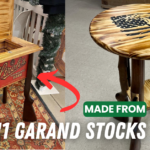I. Understanding the Value of Antique Furniture
II. Creative Upcycling Ideas for Antique Pieces
III. Tips for Restoring and Maintaining Upcycled Furniture
Understanding the Value of Antique Furniture
Have you ever found yourself wandering through a quaint little shop filled with unique collectibles, and your eyes landed on a stunning piece of antique furniture? There’s something special about these older pieces that can make your heart skip a beat. But what exactly gives antique furniture its value? Let’s dive into this fascinating topic!
What Makes Furniture “Antique”?
First things first, to be considered antique, a piece of furniture generally needs to be at least 100 years old. However, age alone isn’t the only factor that contributes to its value. Here are a few other elements to consider:
- Condition: The state of the furniture plays a significant role. A well-maintained piece can command a higher price than one that is damaged or heavily worn.
- Rarity: Unique or rare items often fetch a higher value. If it’s one-of-a-kind, you can bet that collectors will be interested!
- Provenance: The history or origin of the piece adds to its allure. If it once belonged to a notable person or was crafted by a respected artisan, its value can skyrocket.
Why Invest in Antique Furniture?
Now that you understand what makes furniture antique, you might be wondering why investing in antique pieces is a smart choice. Here are some compelling reasons:
- Timeless Charm: Antique furniture adds a unique character to any space. Unlike mass-produced modern furniture, antiques come with stories and craftsmanship that infuse warmth into your home.
- Quality Craftsmanship: Many antiques were handmade with attention to detail, using high-quality materials that have stood the test of time. You’ll often find that they’re sturdier than contemporary pieces.
- Investment Potential: While trends in furniture can come and go, antique pieces often hold or appreciate in value over time. If you choose wisely, your investment could pay off in the long run.
How to Identify Valuable Antique Furniture
If you’re on the hunt for antique furniture, here are a few tips to help you identify valuable pieces:
- Research Styles: Familiarize yourself with different periods and styles of furniture, such as Victorian, Edwardian, or Mid-Century Modern. Each has its own characteristics that can help in identification.
- Examine Construction Techniques: Look for traditional joinery methods, like dovetail joints or mortise and tenon. These indicate quality craftsmanship.
- Check for Markings: Some pieces may have maker’s marks or labels that can give you insights into their origin and value.
In conclusion, understanding the value of antique furniture is about more than just age; it’s about the stories they carry and the craftsmanship behind them. Whether you’re an avid collector or just someone who appreciates unique decor, antique furniture can add a world of depth and character to your home. So, next time you stumble upon that perfect piece, remember its worth extends far beyond its price tag!
Creative Upcycling Ideas for Antique Pieces
Upcycling antique furniture is like giving a beloved old friend a stylish makeover—something fresh while still holding onto its unique character. If you’re staring at a dusty old chair or an ornate dresser that’s seen better days, you might just find inspiration in these creative upcycling ideas that can breathe new life into your antique treasures!
1. Turn a Dresser into a Stunning Bathroom Vanity
Have an old dresser that’s taken a backseat in your home? Consider transforming it into a chic bathroom vanity! Here’s how you can do it:
– **Choose the Right Size:** Pick a dresser that fits your space and has enough surface area for a sink.
– **Cut Out for Sink:** Measure and cut out a hole for the sink, ensuring it fits snugly.
– **Add Plumbing:** Connect the plumbing to your new beautiful piece.
– **Finish with a Fun Faucet:** A stylish faucet can really accentuate the antique charm!
This project not only saves you money but also adds a unique focal point to your bathroom that no one else will have.
2. Create a Coffee Table from an Old Door
Have a vintage door lying around? That could be the perfect base for a rustic coffee table! Here’s a simple guide:
– **Find Some Legs:** Use old table legs or even wooden crates to elevate your door.
– **Add a Glass Top:** For a sleek and modern touch, consider adding a glass top to protect the wood while showcasing its beauty.
– **Stain or Paint:** Depending on your decor, you might want to sand it down and stain it or slap on a fresh coat of paint.
This coffee table will be a conversation starter, with its unique charm and practical function.
3. Repurpose Old Chairs into Stylish Garden Planters
Those old dining or accent chairs that no longer fit your style can become delightful garden planters! Here’s how to do it:
– **Remove the Seat:** Take off the seat cushion to create space for plants.
– **Paint and Seal:** Use weather-resistant paint to give the chair new life and protect it from the elements.
– **Choose Your Plants:** Succulents or colorful flowers can spill over the sides beautifully.
This project not only adds character to your garden but is also a fantastic way to recycle old pieces!
4. Transform a Bed Frame into a Bench
An old bed frame can make for a charming bench, perfect for your entryway or garden. Here’s a quick guide:
– **Disassemble the Frame:** Take apart the bed frame, keeping the headboard, footboard, and side rails.
– **Reconfigure:** Attach the headboard and footboard to the side rails to form a bench shape.
– **Add Cushioning:** For comfort, add a cushioned seat or throw pillows.
This cozy bench will surely be a favorite spot for family and friends!
5. Make a Statement with A Wall-mounted Shelf
An old cabinet door or a beautiful vintage shelf can be the perfect base for a stylish wall-mounted shelf. Here’s how to get started:
– **Select Your Door:** Look for a cabinet door with interesting details or carvings.
– **Paint or Stain:** Refresh its look with paint or a wood-stain finish.
– **Mount it Up:** Secure it to the wall for a stylish display area for books, plants, or decorative items.
This not only declutters your space but also provides a charming display for your favorite items.
Get Creative!
Upcycling antique furniture is all about creativity and fun! Don’t be afraid to mix and match ideas or add your personal touch. Before you know it, you’ll have transformed those hidden gems into functional and fabulous pieces that tell a story and add character to your home. Happy upcycling!
Tips for Restoring and Maintaining Upcycled Furniture
Restoring and maintaining upcycled furniture can be a delightful journey, breathing new life into antique pieces while preserving their unique character. Whether you’ve transformed an old chair into a chic statement piece or revamped a vintage dresser into a stylish storage solution, here are some friendly tips to help you keep those treasures looking fabulous for years to come!
1. Start with a Gentle Clean
Before diving into any restoration work, give your upcycled furniture a good clean. Use a soft, damp cloth to wipe away dust and grime. For more stubborn stains, consider mixing a little mild soap with water.
- Tip: Avoid harsh chemicals that could damage the original finish.
2. Inspect for Damage
Take a close look at your furniture. Check for scratches, dents, or loose joints. This is crucial for planning your restoration process. If you notice any issues, note them down!
- Joint Repair: Use wood glue to fix any loose joints. Clamp them tightly until the glue dries.
- Scratch Repair: For minor scratches, consider using a wood filler or a touch-up marker that matches the wood.
3. Sanding and Painting
If you’re looking to repaint or refinish, sanding is a key step. Gently sand the surface with fine-grit sandpaper to create a smooth base for your new finish.
- Pro Tip: Always sand in the direction of the wood grain to avoid scratches!
Once sanded, you can choose to paint, stain, or apply a clear sealant. If you’re going for paint, consider using chalk paint for a matte finish that’s both trendy and easy to work with.
4. Choose the Right Finish
The finish you choose can significantly impact the look and durability of your piece. Here are some options:
- Polyurethane: Great for durability, especially on surfaces that see a lot of use.
- Wax: Provides a lovely, soft sheen and is easy to reapply when needed.
- Oil: Enhances the natural beauty of the wood but may require more frequent reapplication.
5. Keep It Protected
Once your piece is restored, it’s essential to protect it. Place felt pads under the legs of tables and chairs to prevent scratches on your floors. Additionally, avoid placing hot or wet items directly on the surface.
6. Regular Maintenance
Just like any other piece of furniture, upcycled items benefit from regular maintenance. Here are a few simple steps to keep them looking great:
- Dust Regularly: Use a soft cloth to dust your furniture weekly.
- Reapply Finish: Depending on the finish type, reapply wax or oil every few months.
- Check for Wear: Periodically inspect for any signs of damage or wear and tackle repairs promptly.
By following these friendly tips, you’ll not only restore your upcycled furniture beautifully but also maintain it for years to come. Enjoy the process, and remember that every scratch and patina tells a story!



Comments